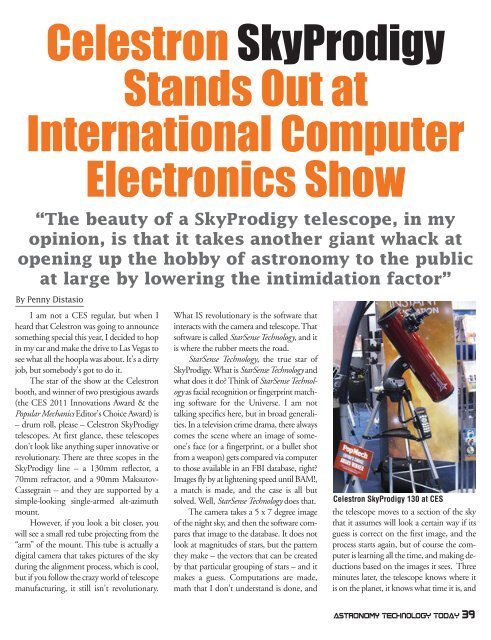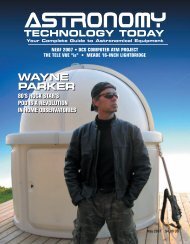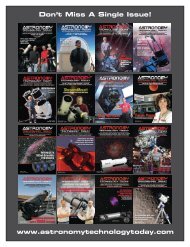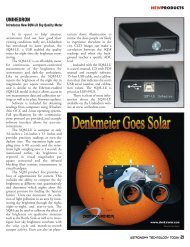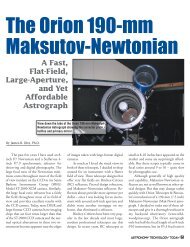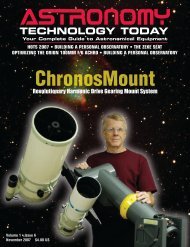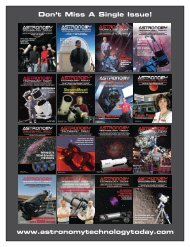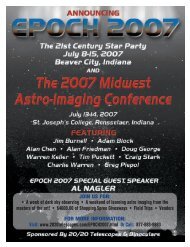magnilux - Astronomy Technology Today
magnilux - Astronomy Technology Today
magnilux - Astronomy Technology Today
You also want an ePaper? Increase the reach of your titles
YUMPU automatically turns print PDFs into web optimized ePapers that Google loves.
Celestron SkyProdigy<br />
Stands Out at<br />
International Computer<br />
Electronics Show<br />
“The beauty of a SkyProdigy telescope, in my<br />
opinion, is that it takes another giant whack at<br />
opening up the hobby of astronomy to the public<br />
at large by lowering the intimidation factor”<br />
By Penny Distasio<br />
I am not a CES regular, but when I<br />
heard that Celestron was going to announce<br />
something special this year, I decided to hop<br />
in my car and make the drive to Las Vegas to<br />
see what all the hoopla was about. It's a dirty<br />
job, but somebody's got to do it.<br />
The star of the show at the Celestron<br />
booth, and winner of two prestigious awards<br />
(the CES 2011 Innovations Award & the<br />
Popular Mechanics Editor's Choice Award) is<br />
– drum roll, please – Celestron SkyProdigy<br />
telescopes. At first glance, these telescopes<br />
don't look like anything super innovative or<br />
revolutionary. There are three scopes in the<br />
SkyProdigy line – a 130mm reflector, a<br />
70mm refractor, and a 90mm Maksutov-<br />
Cassegrain – and they are supported by a<br />
simple-looking single-armed alt-azimuth<br />
mount.<br />
However, if you look a bit closer, you<br />
will see a small red tube projecting from the<br />
“arm” of the mount. This tube is actually a<br />
digital camera that takes pictures of the sky<br />
during the alignment process, which is cool,<br />
but if you follow the crazy world of telescope<br />
manufacturing, it still isn't revolutionary.<br />
What IS revolutionary is the software that<br />
interacts with the camera and telescope. That<br />
software is called StarSense <strong>Technology</strong>, and it<br />
is where the rubber meets the road.<br />
StarSense <strong>Technology</strong>, the true star of<br />
SkyProdigy. What is StarSense <strong>Technology</strong> and<br />
what does it do Think of StarSense <strong>Technology</strong><br />
as facial recognition or fingerprint matching<br />
software for the Universe. I am not<br />
talking specifics here, but in broad generalities.<br />
In a television crime drama, there always<br />
comes the scene where an image of someone's<br />
face (or a fingerprint, or a bullet shot<br />
from a weapon) gets compared via computer<br />
to those available in an FBI database, right<br />
Images fly by at lightening speed until BAM!,<br />
a match is made, and the case is all but<br />
solved. Well, StarSense <strong>Technology</strong> does that.<br />
The camera takes a 5 x 7 degree image<br />
of the night sky, and then the software compares<br />
that image to the database. It does not<br />
look at magnitudes of stars, but the pattern<br />
they make – the vectors that can be created<br />
by that particular grouping of stars – and it<br />
makes a guess. Computations are made,<br />
math that I don't understand is done, and<br />
Celestron SkyProdigy 130 at CES<br />
the telescope moves to a section of the sky<br />
that it assumes will look a certain way if its<br />
guess is correct on the first image, and the<br />
process starts again, but of course the computer<br />
is learning all the time, and making deductions<br />
based on the images it sees. Three<br />
minutes later, the telescope knows where it<br />
is on the planet, it knows what time it is, and<br />
<strong>Astronomy</strong> TECHNOLOGY TODAY 39


